
Meal tent, with my dog running to investigate.
|

Harley Armstrong, regional paleontologist, BLM Grand Junction office.
|

Meal tent. Left to Right: ??, Mike DeLong, Virginia Tidwell (behind Mike), Bruce Schumacher, Shirley Alvarez, Mark Marciniak (DMNH lab volunteer), Jim Cornette, Berry Weis (DMNH PJ volunteer)
|

Meal tent. Right to left: Virginia Tidwell (behind Mike), Mike DeLong, Bruce Schumacher (paleontologist, U.S. Forest Service), Shirley Alvarez
|
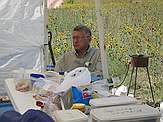
Jim Cornette
|

Virginia Tidwell, research associate at DMNS; Mike Delong in foreground
|

Quarry
|

Quarry
|

Quarry. Jim Cornette (foreground) and Bruce Schumacher, paleontologist, U.S. Forest Service.
|
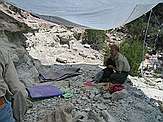
Quarry: Bruce Schumacher, paleontologist, U.S. Forest Service
|

Berry Weis, DMNH PJ volunteer (left), Virginia Tidwell, research associate at DMNS (right)
|

Quarry
|

Mike DeLong "moving mountains of rock" with one of the hand held jackhammers. Mark Marciniak (DMNH lab volunteer) keeping large debris from hitting the dinosaur bone.
|
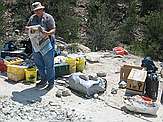
Shirley Alvarez catching a bit of news as she prepares to wet the newspaper which goes underneath the jacket.
|

Left to right: Virginia Tidwell, research associate at DMNS; Bruce Schumacher (paleontologist, U.S. Forest Service); Harley Armstrong (Regional paleontologist, BLM Grand Junction office).
|

Preparing plaster for the jackets. Virginia scoops dry plaster material while Shirley mixes it with water in the tray.
|

Preparing plaster for the jackets. Virginia scoops dry plaster material while Shirley mixes it with water in the tray.
|

Some of the surrounding geology. Darker colors on top (tan, dark brown) are the Dakota Formation. Lighter colors (white, grey) are the Lytle Formation.
|

Some of the surrounding geology. Darker colors on top (tan, dark brown) are the Dakota Formation. Lighter colors (white, grey) are the Lytle Formation.
|

Sauropod femur (?)
|

Sauropod femur (?) with rib underneath (near top of WIPS scale)
|

Rib
|

Jacketed bone
|

Jim Cornette recording notes (left) & Virginia Tidwell, research associate at DMNS; cutting burlap for jackets (right)
|

Tom Nolan, WIPS
|

Quarry
|

Just below the Morrison Formation is the reddish Ralston Creek Formation
|
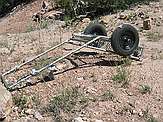
The Dino-Cart used to haul bones and equipment
|

Process of jacketing: (1) Cover bone with wet newspaper before applying burlap/plaster strips.
|

Process of jacketing: (2) Applying burlap/plaster strips, being careful to cover bone only down to the level of the rock pedestal.
|

Process of jacketing: (3) Applying burlap/plaster strips, wet burlap strips in yellow bin (foreground) are ready for plaster and wrapping.
|

Process of jacketing: (4) Applying burlap/plaster strips.
|

Process of jacketing: (5) Applying burlap/plaster strips, being careful to cover bone only down to the level of the rock pedestal.
|

Process of jacketing: (6) Applying burlap/plaster strips, being careful to cover bone only down to the level of the rock pedestal.
|

Process of jacketing: (7) Bone fully jacketed on pedestal. It must dry now before removal (popping).
|

Process of jacketing: (8) After jacket dries, thin steel chisels are used to "pop" the jacket bone from the rock pedestal. This specimen came off flawlessly. Jacketed bone on blue mat (right). Remaining rock pedestal (left).
|

Jacketed bone on blue mat after "popping" from rock pedestal.
|

Sauropod bones being recovered from quarry. Compare this image to the next. Bone at middle, right has been removed in the next image. And, the bone at right has been cleared and is on a pedestal in the next image.
|

Sauropod bone on a pedestal, ready for jacketing.
|

Sunflowers near meal tent.
|

Sunflowers near camping area.
|
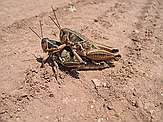
Grasshoppers enjoying themselves on road to quarry. Maybe they will be fossils someday... or their offspring?
|

